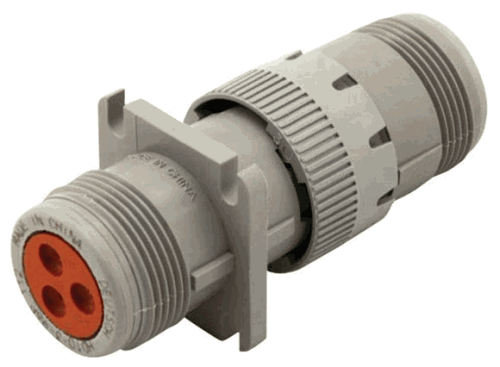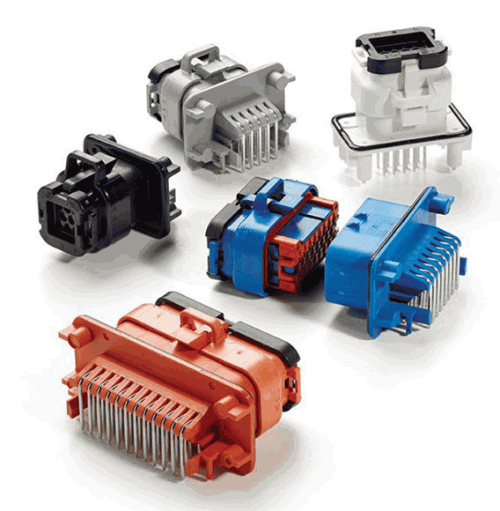
Purchasing the right connector or connector system for your application takes a clear understanding of your application, the environment it will be working in, and any additional environments it might encounter during shipping, installation, or operation. Knowing what connector options your design might need, and what’s available, are critical to your final decision.
Every industrial, automotive, consumer, and communications application uses some type of connector for its electrical and electronics interconnection. Connectors have become the one product that saves time in installing, maintaining, and replacing electrical and electronics equipment.
Skimping on connector integrity often has a disruptive effect on product life cycles. Depending on your application, one or many of the connectors used must incorporate some level of sealing, vibration resistance, and/or temperature variation – often when the design team doesn’t realise it.
Fluids of any kind, from water to detergents to chemicals, can infiltrate a connector and instantly reduce or eliminate the flow of data and electricity.
Similarly, extreme temperatures, whether in the arctic or the desert – or on the factory floor – can degrade a connector’s ability to operate efficiently.
Other characteristics that might adjust your connector’s operations include unexpected vibration and shock, as well as continual motion of any kind. Managing these and other factors is important in assuring that your equipment will operate properly for the life of the product, protecting vital data and power from the expected and unexpected environment.
The focus of this article is to suggest that even when there are differences in applications there are often similarities in function for connectors. Although it might not be recognised as such, there are often harsher environments in markets where you might not expect them.
With the proper connector, broader application uses can be enabled while reducing size, weight, and overall costs. For example, the transportation industry – whether on-highway, off-highway, or recreational – has established a benchmark for high-quality connection devices that is overlooked when designing for applications such as portable power equipment, aftermarket vehicle modifications, digital billboards, commercial grade white goods, food processing, robotics, and medical equipment. And these applications are just as likely to need similar environmentally sound, high-quality connectors.
Connector concerns
If cost were not an issue, engineers would purchase the perfect electrical connector every time. All connectors would offer compact sizes with hermetically sealed, temperature- and vibration-resistant cases. They’d all be easy to use and inexpensive.
The only concern would be to calculate the number of cavities needed, what gauge wire to use, and how many units were required for a particular application. After all, one small crack, leak, or slippage in a connector could break contact in your electrical system; this has the potential to stop production, enable a medical machine to give false data, or cause a vehicle to break down.
There are functions that are necessary for harsh environments that are also valid benefits in less critical applications. For example, how connectors are held together – whether push-latch, a threaded coupling ring, or a jackscrew – will dictate how well they operate under stress (Figure 1). Connectors need to be secure and hold in a mated position securely while allowing for easy disconnect. Often a tactile signal can provide confidence that the connector is mated properly.

Mounting is another important factor to consider. For example, in-line connectors embedded into the harness can be positioned anywhere on a system.
These connectors are used to provide harness coupling and harness breakouts to other areas of the system. They can be mounted using flanges and clips to help secure them to panels, brackets, machine frames, and other solid surfaces.
Bulkhead connectors are in-line connectors that have been adapted for passing through a panel, such as from a chassis to a cab, whether in an automotive, agricultural, or aircraft system. The bulkhead often requires a gasket or other sealing system to limit ingress of moisture, dust, or even noise. Furthermore, header connectors can be used for mounting to a printed circuit board. These connectors vary widely in density from low count to very high count and may be configured with straight or 90° pins depending on the needs of the application.
Engineers, while designing new equipment, might overlook that a piece of equipment might need to be shipped long distances in high-temperature situations during the shipping process, or that vibration during shipping could jar connectors loose. If a machine is delivered in Alaska during winter or sits out on a dock where salt air settles in, connectors need to be able to maintain their integrity. Even in locations such as hospitals or laboratories, connectors may be exposed to cleaning fluids or laboratory spills that could alter a connector’s ability to perform properly.
Here are a few things to consider when trying to decide what connector you want to employ. Even if your application wouldn’t typically require a connector made for harsh environments, remember that the data transferred is still highly valuable.
Water might not always come in the form of rain or floodwater. Water vapour of any kind, from high humidity to low-lying fog coming through an open window, can affect a connector’s ability to flow delicate data. Similarly, dust – whether in an industrial or outdoor setting – can be very harmful to an electrical system’s operation. In fact, the second you move a device outside you have both dust and water to be concerned about.
If you’ve ever been in a hospital or in an emergency vehicle, you know that equipment is treated pretty rough. In any type of emergency, racks of equipment are jostled into place, while connectors are stretched to their maximum and constantly moved into place.
Assuming that delicate medical equipment doesn’t require connectors made for harsh environments could be a mistake. Other considerations include extreme temperatures, especially for portable equipment of any kind, and explosive environments.
Some common solutions
With a growing demand for data, signal, and power connections in equipment of all types, more engineers are making sure their designs can fit into multiple environments without the concern for potential failure. Connectors, as key elements in every design, must provide secure connectivity under unexpected conditions.
Some solutions to key problems are already available in connectors for harsh environments, but every design doesn’t need the most protected connector. This is why companies are beginning to offer a wide variety of solutions. Engineers now have a wide selection of benefits to choose from without having to take them all.
Ingress Protection (IP) ratings are available for both water and dust. For example, a rating of IP67 indicates protection from dust and immersion from 12,5 cm to 1 m. A rating of IP68 protects the connector from dust and long-term immersion up to a specified depth. And, IP69K protects connectors from dust, close-range high pressure, and high-temperature spray-downs for such applications as food and beverage.
Locking or coupling connectors are essential in all harsh environments, but also provide added security in medical and laboratory equipment applications. A wide range of mechanisms are used and should be evaluated for the application you are looking to secure. Along these same lines, many connectors might need to be sealed, whether to keep the connector in place or to prevent water from seeping into the connections.
When deciding on your next connector, consider the shape, thread pattern, or mating latch, as well as the position of the pins – maintaining separation between data and power – all of which play an important part in final operating capabilities.
Terminal structure also needs to be considered. Primary differences include round (pin/socket type) and blade style (box and blade type), where each provides a choice for connector density and usage. For example, round terminals offer less complex termination and installation processes, whereas blade terminals can offer advantages for higher density and production volume.
Terminal termination can be done using lower-volume hand processes for loose pieces and can also scale up for volume using automated processes and strip terminals. Circular connectors are often easier to seal and less likely to wear, while blade and box terminals are great for in-system and on-board applications where data flow is required.
The housing used for a connector can also make a difference in how well it operates. If your connector has the potential to be exposed to corrosive substances, perhaps a metal housing is the right option. For lightweight or flexible operations, there are many plastic composites that are attractive and provide specific attributes depending on the application.
Specific connector attributes
Because connectors are used everywhere, it’s important that design engineers have access to what they need, when they need it without going overboard on capabilities not needed. When you don’t need something as tough as a Mil-Spec part, there are connectors that come very close without the high cost. Furthermore, working with a product that has a variety of options will assure that you can find only what you need.
For this reason, TE Connectivity (TE) provides a wide range of connector types. For example, its Deutsch line of connectors provides a common contact system to allow users to lower their inventory costs over a wide range of application requirements. These field-proven products have the reputation for ease-of-use, lowering labour costs; a wide operating temperature range from -55°C to +125°C (some as high as 150°C); sealed operation in up to 1 metre of water; and are competitively priced to make selection an easy decision.
The Deutsch DT connector series (Figure 2) are wire-to-wire sealed and come in position quantities of 2, 3, 4, 6, 8, and 12 positions for wire gauges of AWG #20-AWG #14 (wire-to-board options are available). These devices are rated for IP68. Contacts for these connectors are available in tin, nickel, or gold plating options. They offer inline, flange-mount, and PCB options as well, with four polarisation wedge-locks and mounting clips available. The series provides DT Detector for 12 and 24 V applications, where the housing provides a visual confirmation of power by using an integrated LED to provide a glow to the transparent housing.

AMPSEAL connectors (Figure 3) are designed with an advanced environmental sealing capability for heavy-duty wire-to-board applications. They handle wire sizes from #16-#20 AWG in connector sizes of 8, 14, 23, and 35 positions using a 1,3 mm pin and socket system. Vertical and right-angle header options make them easy to design into a wide variety of systems. They are also available with strain-relief covers in multiple colours.
TE’s AMP SUPERSEAL 1,0 mm connectors provide high-density packaging specifically for space-sensitive applications such as vehicle device and compact industrial applications. With a sealed wire-to-board interconnect and sizes of 26, 34, and 60 position plug connectors using #16-#20 AWG wire sizes, these connectors provide a two-row plug available format for narrow packaging applications.
TE’s AMP MCP interconnect system is a family of high-density connectors (up to 120 positions) that incorporate lever and locking latch assisted connector housings for wire-to-wire, bulkhead, and PCB/device applications. These connectors can handle a wire range from #10-#24 AWG and are IP69K certified.
Conclusion
Selecting the right connector has always been a challenge since they are located at the most vulnerable parts of a system – where power and data are entering and exiting. Being sure you understand the needs of your application from build through shipping through installation and operation will allow you to better select the connector you may need.
Even though your system might be used in a clean room or hospital laboratory, you must take into consideration the environment it entails getting there as well as any emergency situation the system may be faced with during the life of its service.
| Email: | [email protected] |
| www: | www.trxe.com |
| Articles: | More information and articles about TRX Electronics |

© Technews Publishing (Pty) Ltd | All Rights Reserved